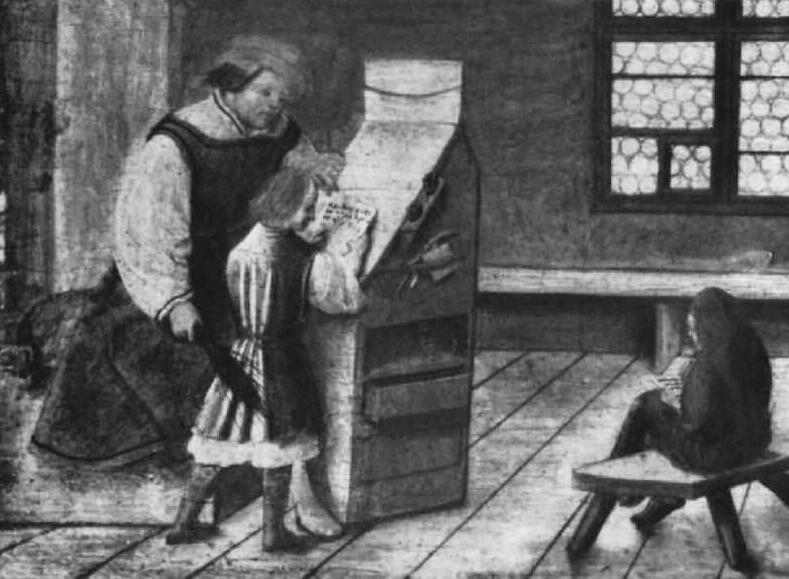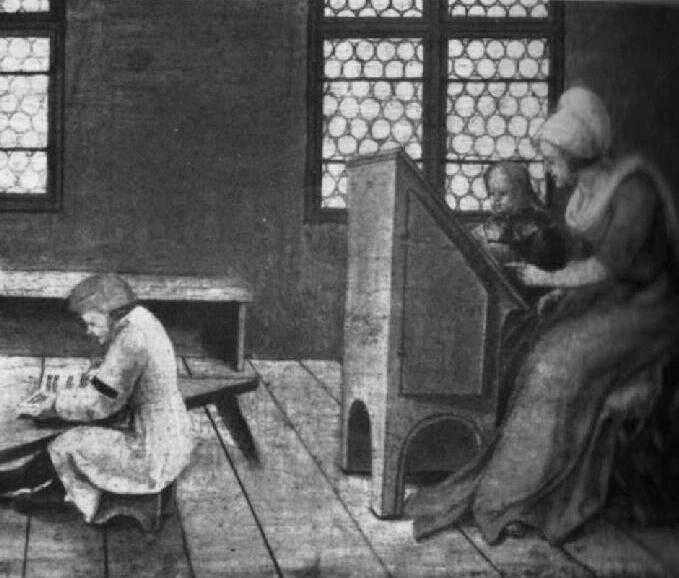
Individual Swiss Schools: Myconius' School (Berne, 1516)

Figure 1.--Hans Holbein the Younger has provided us a glimpse of a schoolin 1516. It is apparently a school operated by his friend Oswald Myconius, we think in Berne. Apparently Mycronius did not think that the young scholar he is teaching was not sufficently motivated.
|
|
Hans Holbein the Younger has provided us a glimpse of a school in 1516. It is apparently a school operated by his friend Oswald Myconius, we think in Berne. While this is in Switzerland, it probably represents a reasonable depiction of schools throughout Germany. Myconius could not pursue a clerical career because he married. This was why many men turned to teaching at the time. His wife is helping in his school class. This of course changed with the Reformation when Protestant churches allowed clerics to marry. Note how few children that they are teaching. The painting here is very elongated, leading some art experts to speculate that it was hung over the door of the school in Berne as a kind of advertisement.
Berne
Hans Holbein the Younger (1497-1543)
Hans Holbein the Younger has provided us a glimpse of a school (1516). The sign painted here was done quickly as a favor for a friend when Holbein was very young. Holbein was in fact become one of the great portraitists of all time.
Hans was born in Augsburg, Germany (197/98). His father was also a painter--Hans Holbein the Elder. Hans and his brother Ambrosius learned their craft in their father's studio. Their father sent the youths to Basel to work under the directiin of Hans Herbster (1514). While in Basel, Holbein met the famed humanist--Erasmus. He would paint a masterful portrait of Erasmus. Holbein went to Luzern where he decorated the house of the magistrate (1517). He ten traveled to Italy to see the work of the great Itakin Renaissance masters (1518). Holbein was accepted as a member of the painters’ guild in Basel (1519). He was by this time recognized as a master. He married Elsbeth Binsenstock.
The Reformation and resulting fighting and dislocation affected Basel and Holbein could no longer prosper there. He decided to move to England (1526-28). He had letters of introduction from Erasmus. Here with is reputation he found lucrative commissions. One of his great works is the portrait of Sir Thomas Moore, at the time Lord Chancellor. He returned to Basel for a time, but returned to England (1532). He worked almost exclusively as a portrait painter, primary under the patronage of King Henry VIII and the court.
Holbein died of the plague (1543).
Oswald Myconius (1488-1552)
Myconius was born at Lucerne, Switzerland (1488). His father who was a miller was named Geisshüsler.
As a boy he studied at Rottweil, on the Neckar. He then studied the classics at the University of Basel. Apparently he decided against a clerical career which was a common career path for university scholars. We are not sure whu, but apparently he wanted to marry. He set up a school in Basel (1514). At at this time he married. He became friendly with Erasmus and Hans Holbein. The Latin term for miller was "molitor". Thus once he became educated, he was known as Molitoris. And finally he adopted the name Mycronius. This appears to have been originated by his friend Erasmus who translated the original family name into Greek. I am not entirely sure why he had these names, but it apparently was a way of enphasising his academic credentials to parents. When Holbein painted this scene was a humbel school master. As it was painted by Holbein, we think it depicts Mycronius' school in Berne. Here he is teaching only basic reading and writing.Mycronius may have taken it with him when he moved to Zürich (1516). He continued to teach in Zürich. While at Zurich he was impressed by Zwingli and joined his reforming party. This led to a move to Lucerne (1518). He returned to Zürich (1523). Once Luthur launched the Reformation, Mycronius adhere to the cause of church reform. He became a follower Huldrych Zwingli. He would rise to become an estemed professor of the University Basle and write a respected biolgraphy of the important Reformer Zwingli.
Erasmus (1466/1469-1536)
Desiderius Erasmus was born in Rotterdam (1467/69). He emerged as a towering intellectual figure and noted humanist of the Northern Renaissance. He was the most repected intelectual figure of his age in part because of his matery of Latin. It was not an easy time for intelectuals in Europe. Erasmus was a proponent of church reform even before Luthir launched the Reformation. His criticm of the Church angered Catholics. And his continuing cimmitment ti reform from within frustrated Luther. Erasmus began to feel endangered because of his views. He moved to Berne which the Swiss provided a more tolerant intellecual environment. It was here he came in cotact with the humble school teacherwho he named Mycronius.

Figure 2.--Here we see Maconius' wife using a little more gentle method on a girl student. It is unxlear whst the division of labor was betweem Maconius and his wife. The painting suggests that she worked with the girls. Perhaps she also worked with the younger boys. Also notice that there are almost no books visible. Bokks atvthe time were still very expensive even though printing was becoming increasingly important.
|
|
Schoolmasters
The Catholic Church dominated schools throughout Western Christendom during the Medieval period. This was because it was only the Chutch that maintained learning. Even the universities which appeared in the lae medieval period were administered by the Church. Most teachers were churchmen or individuals trained by the Church. The teacher here, Myconius, could not pursue a clerical career because he married. This was why many men turned to teaching at the time. His wife is helping in his school class. This of course changed with the Reformation when Protestant churches allowed clerics to marry.
Chronology
We know when this scene occurred because the Holbein painting is date to 1516 durung the Northern Renaissance. It seems likely that the painting depicts what schools and teaching methods would have looked like during the late medieval era.
The School
The painting apparently illustrates a school operated by Holbein's friend Oswald Myconius, we think in Berne. While this is in Switzerland, it probably represents a reasonable depiction of schools throughout Germany. Note how few children that they are teaching. The painting here is very elongated, leading some art experts to speculate that it was hanging sign, placed over the door of Myconius' school as a kind of advertisement. Note that Myconius appears to have used a borch rod as an important teaching tool. The fact that he would have this put over the door of his school speakd volumes. It is how teachers taught and their clients expected them to teach. One would think thsat the children about to enter the school would not be to impressed, but in the 16th century children dud what they were told for obvious reasons. His wife uses more gentel methods. Note that both boys and girls are being taught. This is a change from the medieval period. Mycronius would become an important Protestant reformer, this may be a factor in the education of girls. His wife worked with him in the school, but she probably could not have founded a school on her own. Subsequently in Protestant countries, we do begin to see dame schools.
Schoolwear
Tge painting is not real clear, but the boys look to be wearing tunics. They are not as short as the tunics we see in Italy, but they are shorter than the jumper-type robe that Maconius is wearing.
The Reformation in Switzerland
HBC-SU

Related Chronolgy Pages in the Boys' Historical Web Site
[Main Chronology Page]
[The 1880s]
[The 1930s]
[The 1940s]
[The 1950s]
[The 1960s]
[The 1970s]
[The 1980s]
Related Style Pages in the Boys' Historical Web Site
[Return to the Main individual Swiss school alphaberical page]
[Return to the Main individual Swiss school 1930s page]
[Return to the Main individual Swiss school page]
[Main Swiss smock page]
[Main country page]
[Long pants suits]
[Short pants suits]
[Socks]
[Eton suits]
[Jacket and trousers]
[Blazer
[School sandals]
Navigate the Boys' Historical Clothing School Uniform Pages
[Main School Uniform Page]
[Australia]
[England]
[France]
[Germany]
[Italy]
[Japan]
[New Zealand]
[Scotland]
[United States]
Navigate the Boys' Historical Clothing Web Page
[Return to the Main medieval school page]
[Introduction]
[Activities]
[Biographies]
[Chronology]
[Clothing styles]
[Countries]
[Bibliographies]
[Contributions]
[FAQs]
[Glossary]
[Images]
[Links]
[Registration]
[Tools]
[Boys' Clothing Home]
Created: 2:53 PM 10/27/2007
Last updated: 3:07 AM 3/29/2009





